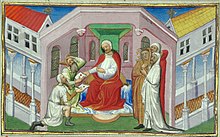Keraites

The Keraits or Kereits (Mongolian: Кэрэйд, Kereid; Kazakh: Керей) were a cluster of tribes in Central Asia, dominant in the area and, as allies of Genghis Khan, influential in the rise of the Mongol Empire. Converted to Nestorian Christianity in the 11th century, they were also a key example of prominent Christians among the Mongols. The leader of the clan, Toghrul, gained fame as far away as Europe for his battles with Muslims, and several women from the Kerait clan became influential women in the Mongol court. Sorghaghtani Beki married a son of Genghis Khan, and their four sons, including Great Khans Kublai Khan and Mongke Khan, became prominent leaders of the Empire.
Origin
The Keraits first enter into history as the ruling faction of the Zubu confederacy, a large alliance of tribes that dominated Mongolia in the 11th and 12th centuries and often fought with the Liao Dynasty of northern China, which controlled much of Mongolia at the time. After the Zubu confederacy broke up, the Keraits retained their dominance on the steppe right up until they were absorbed into Genghis Khan's Mongolian state.
Location
They lived in the area between the Orkhon and the Kherlen rivers, to the east of the tribe of the Naimans.
Ethnicity
The Kerait nation was a collection of unrelated tribes of both Mongolian and Turkic ancestry.
Nestorianism
The Kerait were converted to Nestorianism, a sect of Christianity, early in the 11th century.[1][2] Other tribes evangelized entirely or to a great extent during the 10th and 11th centuries were the Naiman and the Merkit.
An account of the conversion of the Kerait is given by the 13th century Jacobite historian Gregory Bar Hebraeus. According to Hebraeus, in early 11th century, a Kerait king lost his way while hunting in the high mountains. When he had abandoned all hope, a saint appeared in a vision and said, "If you will believe in Christ, I will lead you lest you perish." He returned home safely. When he met Christian merchants, he remembered the vision and asked them about their faith. At their suggestion, he sent a message to the Metropolitan of Merv for priests and deacons to baptize him and his tribe. As a result of the mission that followed, the king and 20000 of his people were baptized.[3][4] Rashid al-Din says in the Jami al-Tawarikh that the Kerait "are given over to the worship of Jesus". William of Rubruck, who encountered many Nestorians during his stay at Mongke Khan's court and at Karakorum in 1254-1255, notes that Nestorianism in Mongolia was tainted by shamanism and Manicheism and very confused in terms of liturgy. He attributes this to the lack of teachers of the faith, power struggles among the clergy and a willingness to make doctrinal concessions in order to win the favour of the Khans.
The legend of Prester John, otherwise set in India or Ethiopia, was also brought in connection with the Nestorian rulers of the Kerait. In some versions of the legend, Prester John was explicitly identified with Toghrul.[1] But Mongolian sources say nothing about his religion.[5]
Wang Khan

The Kerait khan Toghrul was granted the title of Wang Khan (King) by the Jin Emperor in 1183. Toghrul is best known as patron and one of the early allies of Temüjin (later Genghis Khan), until they fell into disagreement over Temüjins growing power.
In 1203, Temüjin defeated the Kerait, who were distracted by the collapse of their own coalition. Toghrul tried to escape to the Naimans, but was killed by a Naiman warrior who didn't happen to recognize him. The remaining Kerait submitted to Temüjins rule, but out of distrust he dispersed them among the other Mongol tribes.
Notable members
- Markuz Buiruk Khan, Kerait leader who also lead the Zubu confederacy and was eventually killed by the Liao Dynasty in 1100.
- Wang Khan (Toghrul), grandson of Markuz Buiruk Khan, leader of the clan, who was associated with the legend of Prester John.
- Sorghaghtani Beki, niece of Toghrul, eldest daughter-in-law of Genghis Khan, mother of Great Khans Kublai Khan, Mongke Khan, and Ilkhanate-founder Hulagu Khan[1]
- Rinchin, protected Christians when Ghazan began to presecute them. But he was executed by Abu Said when fighting against his custodian Chupan of the Suldus clan in 1319.
Modern times
People with clan name Kerait are still found among the Ordos and the Baarin in Inner Mongolia as well as among northern Khalkha people in Mongolia. Another descendants of Kerait are the Karaylar or Kerey tribe within the Middle Juz of the Kazakh nation. According to oral tradition, the Torghuds are also thought to be the descendants of Wang Khan's bodyguards.
See also
References
- ^ a b c Li, Tang (2006). "Sorkaktani Beki: A prominent Nestorian woman at the Mongol Court". Jingjiao: the Church of the East in China and Central Asia. Steyler Verlagsbuchhandlung GmbH. ISBN 9783805005340.
{{cite book}}:|work=ignored (help); Unknown parameter|editors=ignored (|editor=suggested) (help) - ^ Silverberg, Robert (1972). The Realm of Prester John. Doubleday. p. 12.
- ^ Cite error: The named reference
groussetwas invoked but never defined (see the help page). - ^ Moffett, A History of Christianity in Asia pp. 400-401.
- ^ Atwood, Christopher P. Encyclopedia of Mongolia and the Mongol Empire. ISBN 0816046719.
References
- Khoyt S.K. Kereits in enthnogenesis of peoples of Euroasia: historigraphia of the problem. Elista, 2008. 82 p. ISBN - 978-5-91458-044-2 in russian
- Хойт С. К. Кереиты в этногенезе народов Евразии: историография проблемы. Элиста, 2008. 82 с. ISBN - 978-5-91458-044-2
